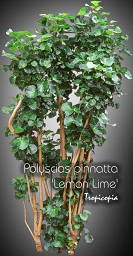Table of contents
Balfour aralia

Latin Name: Polyscias pinnata ‘Lemon Lime’
Category: Aralia
Family: Araliaceae
Origin: Cultivar
Climate: Tropical
Growing Zones: 11-10
Care Instructions
The Balfour aralia (Polyscias pinnata ‘Lemon Lime’) is a tropical plant that originates from Cultivar. This aralia plant belongs to the Araliaceae family and is well-suited for growing in USDA zones 11-10.
Complete Care Guide for Balfour Aralia (Polyscias pinnata ‘Lemon Lime’)
Watering Requirements
The Balfour Aralia, or Polyscias pinnata ‘Lemon Lime’, thrives best with a consistent watering schedule. It is essential to keep the soil evenly moist but not soggy. Water the plant when the top inch of soil feels dry to the touch. During the growing season, typically spring and summer, you may need to water more frequently, about once a week. In the fall and winter months, reduce watering to every two weeks, as the plant enters a dormant phase. Overwatering can lead to root rot, so ensure that the pot has adequate drainage and avoid letting the plant sit in standing water.
Light Conditions
Balfour Aralia prefers bright, indirect light to thrive. While it can tolerate lower light conditions, too much shade may result in leggy growth and a loss of vibrant color in its leaves. Ideally, place your plant near a window that receives filtered sunlight. If you notice the leaves starting to yellow or drop, it may be a sign that it is not receiving enough light. Conversely, direct sunlight can scorch the leaves, so be cautious of placing it in a spot where it will receive harsh afternoon sun. A balance of light is key to maintaining the health and beauty of this stunning plant.
Soil Preferences
The ideal soil for Balfour Aralia is a well-draining potting mix that retains some moisture without becoming waterlogged. A blend of peat moss, perlite, and pine bark works well to provide the necessary drainage and aeration. It is also beneficial to incorporate a slow-release fertilizer during the growing season to promote healthy growth. Fertilize every 4-6 weeks with a balanced, water-soluble fertilizer diluted to half strength. In the fall and winter, reduce fertilization as the plant’s growth slows down. Regularly checking the soil’s pH level, which should be slightly acidic to neutral (around 6.0 to 7.0), can also help ensure optimal growth conditions.
Pests and Diseases
Balfour Aralia is generally resilient but can be susceptible to common houseplant pests such as spider mites, aphids, and mealybugs. Regularly inspect the undersides of leaves and stems for any signs of infestation. If you notice pests, treat them promptly with insecticidal soap or neem oil, ensuring to cover all affected areas. Additionally, watch for signs of fungal diseases, which can occur if the plant is overwatered or in overly humid conditions. Yellowing leaves, wilting, or a mushy stem can indicate root rot, which requires immediate action. Remove the plant from its pot, trim away any affected roots, and repot it in fresh, dry soil.
Special Care Tips
To keep your Balfour Aralia looking its best, consider the following special care tips. Regularly dust the leaves with a damp cloth to keep them clean and allow for optimal photosynthesis. This also helps prevent pests from settling on the foliage. Pruning is beneficial to maintain the desired shape and encourage bushier growth; trim back any leggy stems or yellowing leaves as needed. Additionally, rotating the plant every few weeks can promote even growth and prevent it from leaning towards the light source. Lastly, be mindful of temperature fluctuations; Balfour Aralia prefers a stable environment, ideally between 65°F to 80°F (18°C to 27°C). Avoid placing it near drafts, heating vents, or air conditioning units to ensure it remains healthy and vibrant.








